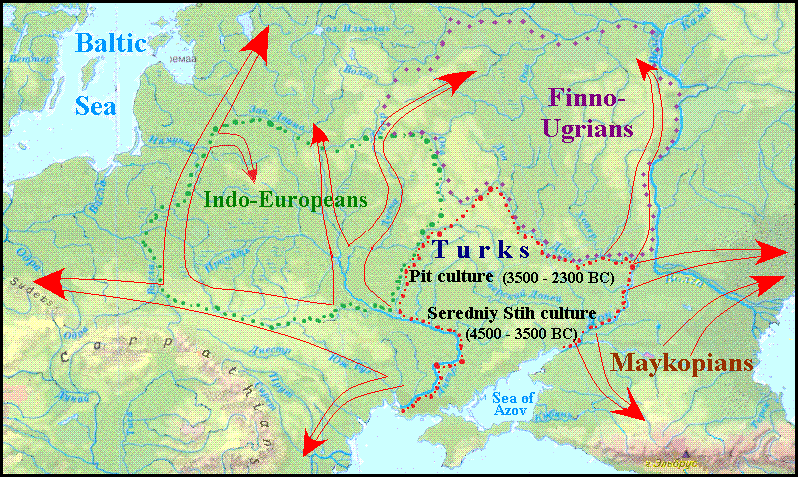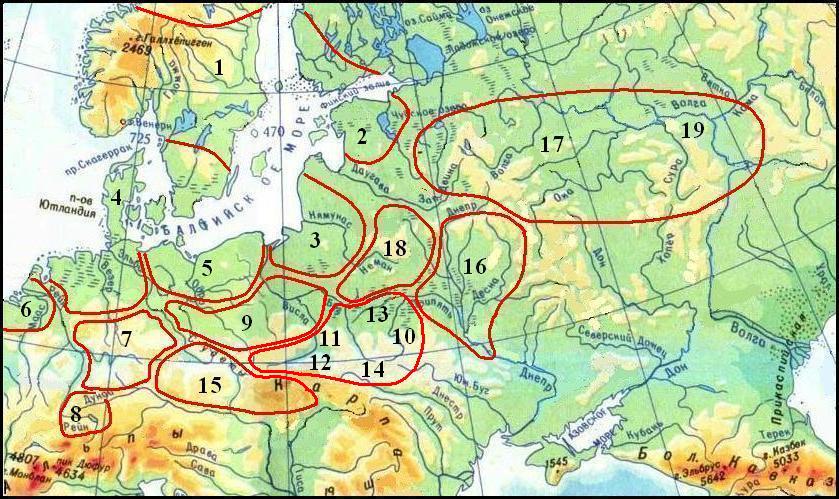Turkic people as Carriers of the Corded Ware Cultures
Based on the proven presence of ancient Turkic people in Eastern Europe (see the section of my website "On One Unsolved Problem in Linguistics"), it was determined that they were the creators of several Corded Ware cultures (see "Ethnicity of the Neolithic and Chalcolithic cultures of Eastern Europe"). Here the topic of the presence and activities of the Turkic people in Europe will be considered in more detail. The Chuvash language as the only one of all the Turkic languages that has preserved some features of the Turkic proto-language plays a key role in this consideration. Among the carriers of the Corded Ware cultures (CWC), there was one tribe that ensured such continuity. We call this tribe the Proto-Chuvash. The original habitat of all the Turkic tribes and their migration routes are shown on the map below.
Ancient Turkic people in Europe.
Archaeological evidence at the beginning of III mill. BC similar cultures appear in Central Europe having such characteristic features as Corded Ware and battle axes. Before that, Central and Western Europe from Portugal to Britain was populated by farmers who came from Anatolia via the Balkans. This is evidenced by paleogenetic data obtained by sequencing DNA chains with a special instrument that appeared at the beginning of the third millennium (KRAUSE JOHANNES mit TRAPPE THOMAS. 2020: 34 and farther).
The radiocarbon method allows dating the appearance of the CWC sites in Małopolska (Kraków-Sandomierz and other groups) to 2900/2800 BC [WŁODARCZAK PIOTR, 2001: 106]. Evidence of the presence or absence of copper items at the CWC sites, taking into account absolute dating, provides grounds to attribute the emergence of these cultures to the late Neolithic [TKACH E.S. 2019-1: 91].

Left: Battle-axes as one main feature of Corded Ware culture.
Stone and copper axes found accidentally in Fore-Carpathia and Podolia.
1. – Rakovchyk, 2. – Pistyn, 3. – Komariv, 4. – Dereviane, 5. – Bedrykivrsi, 6. – Bohorodchany, 7. – Halych, 8. – Dashava (SVESHNIKOV I.K. 1974, Fig. 18)
The complex of the Corded Ware culture, some of which have such names as Fatyanovo, Balanovo, Beaker culture, Single Grave culture, Battle-axe culture, etc was spread on the space from the Volga River to the Rhine, from southern Sweden to the foothills of the Alps and Carpathians.
Turkic people disseminated quickly upon a large space owing to using riding horses and primitive carts. Tractive force could be like horses and bulls. The spread of the Turkic tribes was also due to climatic changes in the arid Subboreal period when the zone of steppes advanced on the north and west and nomadic tribes of cattle breeders moved with it. The extent of this movement is illustrated by the fact that there are only in the Saxony and Thuringia 1300 sites of Corded Ware culture (HERMANN JOACHIM. 1982: 61)
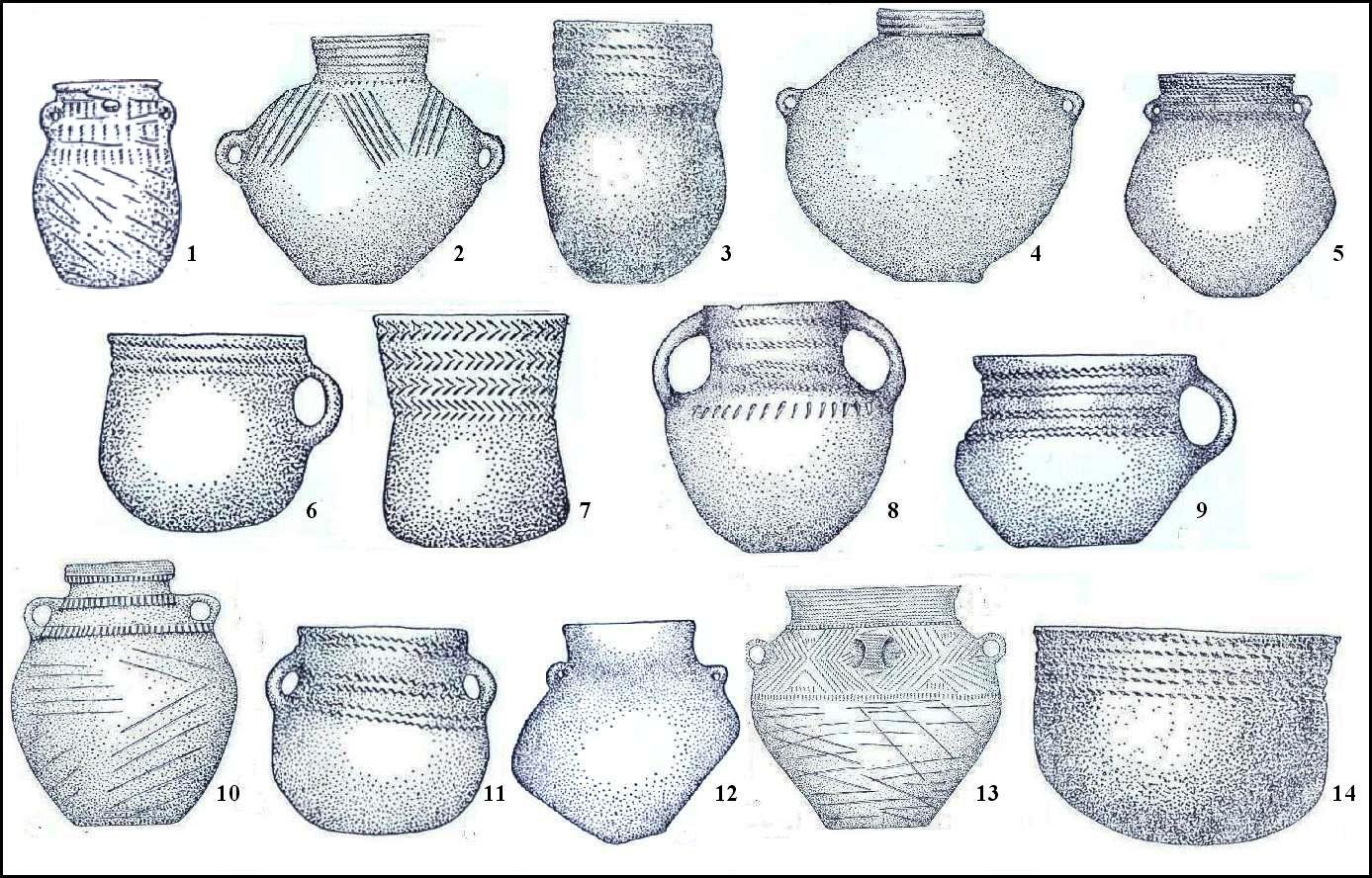
Left: Some types of Corded pottery from Ukrainian sites.
1, 10, 13 – Strzyżów group; 2, 3, 4, 7, 14. – Upper Dnister group; 5, 6, 8, 9, 11, 12. – Zdovbytsia group. (SVESHNIKOV I.K. 1974, Fig. 4, 5, 6, 9, 26, 38, 39, 48)
Although the Trypillians stood at a high level of development at that time and exerted a certain ideological influence on their neighbors, who borrowed from them, for example, the symbol of the “Tree of Life,” the Turkic people gave rise to new European cultural traditions.
They brought with them the image of the Bull and the Phallic saints as a symbol of male power and, as a consequence, the patriarchal clan system, as well as ancestor worship and funeral rites. (ALEKSEYEVA I.L. 1991: 20-21).
Most clearly these effects can be observed in the archaeology of Right-bank Ukraine, in the dissemination of Trypilla culture, especially in the Usatove group near Odesa. Although they have been associated with the cultures of the Balkan-Danubian tradition, "but one of the most important and characteristic features that make separate this group – funeral rites – certainly linked to Old Pit culture tradition" [MASSON V.M., MERPERT N.Ya., 1982: 329]. In addition, clay-ware of the Trypilla culture mixed with sand and pounded shells, a feature that distinguishes Seredniy Stih and Pit cultures, occurs on the banks of the Southern Bug and Ingulets Rivers [ibid., 211]. Human skeleton buried in the back with knees bent, ie in a pose typical of carriers of so-called "Kurgan" cultures, which was found near the village of Nezvisko of Ivano-Frankivsk region, may indicate further advancing Turkic tribes westward. At the same time, the anthropological study of archaeological sites of the North-Western Black Sea Region suggests the process of cross-breeding and mutual assimilation of the Trypillian population and arrived here tribes of Pit culture [ALEKSEYEVA I.L. 1978: 56].
G. Child wrote about the possibility of forming the peculiarities of the sites of the Usatove type based on the Trypillian culture under the domination of foreign chiefs-cattle breeders. Currently, his hypothesis finds followers [PETRENKO V.G. 2013: 208].
One such follower is David Anthony. After analyzing the materials of Odessa archaeologists about the household, clayware, and burials of the Usatove settlements and neighboring Yamna culture, he came to the following conclusion:
The people who founded the Usatove settlement probably were descended from an earlier generation of steppe herders who had lived in the Dniester and South Bug steppes, not from Tripolye farmers who had lived in the uplands. [ANTHONY DAVID W. 2008, 36].
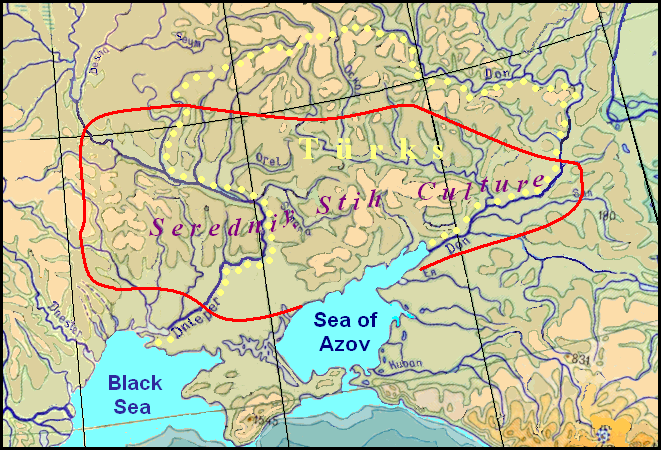
At right: The original territory of the Turkic tribed is the area between the Dnieper and Don Rivers (indicated by yellow dots) and the dissemination area of Seredniy Stih culture (limited by the red line).
The territory populated by the Turkic and the territory of Seredniy Stih culture, which was developed from Pit culture, are the same. However, the spread of Seredniy Stih culture in a sufficiently large area of Right-Bank Ukraine may indicate that the resettlement of the Turkic people beyond the Dnieper occurred much earlier than they started a mass movement in a wide area of Europe. For a while, they were peacefully coexisting with Trypillians.
Trypillian population was very numerous. This is evidenced not only by many dwelling sites of Trypillian culture but also by their size. The study of British scientists and their Ukrainian colleagues using the geomagnetic method allows for estimating the number of individual Trypillian settlements from five to twenty-five thousand people [RASSMANN KNUT. 2014]. There were more than two thousand sites of Trypillian culture in Ukraine with an area from 0.5 to 400 ha [BURDO N.B., POLISHCHUK L.Yu. 2013: 45], and the total population of its territory had counted several million. Such a mass of people could not disappear without a trace, so it can be assumed that the Trypillians were involved in the mass migration process of the Turkic tribes. According to archaeologists' calculations, the number of the Trypillian population, who survived the invasion of nomads, decreased three to four times [VIDEIKO MYKHAILO. 2011: 379], which may testify in favor of such an assumption. The typical Trypillian painted utensils, which can be found in the assemblages of corded ceramics (PETROV V. 1947: 35), betray the presence of Trypillians among the "Cordians". The Turkic people themselves, as nomads, were not so numerous as to settle in the vast expanse of Europe, where traces of the CWC were found.
Living among farmers, Turkic pastoralists acted as a ethnic class and a specific xenocratic (from the gr. ξένος “stranger”, “guest”, “master” and κράτος “strength”, “power”) political system . Figuratively speaking, they represented something like a "superstructure" over the settled agricultural “base” (KRADIN N.N. 1999, quoted from KRADIN N.N. 2007: 27-28). Thus, the Turkic people established a xenocracy regime over the Trypillians, imposing their way of life and language on them, as evidenced by numerous toponyms of Turkic origin in Central and Northern Europe. Linguistic expansion is different. How the assimilation of the language of the conquerors by the autochthonous population takes place was described by the American anthropologist as follows:
Military conquest, another vector of language expansion, carries the language of the conquerors only when it provides the defeated access to the new prestige system at a relatively low social cost—in other words when there is both little negative shame or humiliation for a person’s family if that person cooperates with the conqueror, and widespread positive public recognition or reward for most who cooperate, including the opportunity for their children to advance to higher social positions [ANTHONY DAVID W. 2008: 3].
The Semitic linguistic substrate, adopted by the Turkic people who assimilated the Trypillians, was inherited by the German language when the newly arrived Teutons were superimposed on the speakers of the CWC in Central Europe, and this gives Theo Vennemann reason to speak of the Semitic influence on the German language in vocabulary and typology in his work "Germania Semitica" (VENNEMANN THEO, gen. NIERFELD. 2012).
Of course, numerous Trypillian people, in some cases, where their settlements numbered several thousand inhabitants, could offer serious resistance to the invasion and avoid complete enslavement. An analysis of the archaeological finds of the time confirms this assumption and there is reason to believe that the Trypillian culture continued to exist for quite a long time, undergoing various transformation processes (VIDEIKO MYKHAILO. 2011: 375-380).
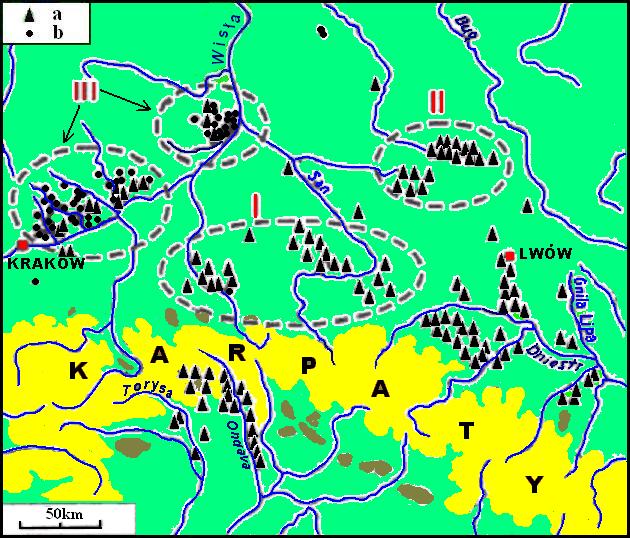
At left: Concentrations of the CWC sites in southeastern Poland, western Ukraine, and eastern Slovakia (By J. Machnik with modifications). a – solitary kurgans and their clusters, b – burial grounds and their clusters. J. Machnik noted by Roman numerals the three stages of development of culture CWC in Poland. The map is taken from the publication The absolute chronology of the Corded Ware culture in south-eastern Poland of Piotr Włodarczak and toned by the author with color.
Local cultures of Corded Ware complex are largely different from each other, but have many common features, the most important of which are:
1. spread in the forest and forest-steppe zone;
2. primary pastoral character;
3. temporary settlements with small hut dwelling type;
4. mainly burial mounds;
5. vessels of bowls and cups type with a rough (often spherical) down, decorated by cord and trees decorated ornament;
6. flint rectangular cross-sectional axes and stone axes of various types;
7. a significant amount of armaments;
8. patriarchal clan system;
9. traces of the cult of the sun and the earth;
10. Common (proto-European) anthropological features (SVESHNIKOV S.K. 1974: 170).
Trypilla culture developed mainly based on agriculture, which has lost its effectiveness due to soil depletion without using fertilizers and crop rotation. At the time, nomadic livestock gave more surplus products, as it could make better use of steppe resources. As a result, the mutual assimilation of the Trypillians and Pit people was accompanied by the transition to nomadic cattle-breading. However, due to population growth and the beginning of the using more advanced cultivation methods, a return to agriculture became inevitable. For approximately five centuries people in the middle and upper Dniester River have carried a settled life. Archaeological sites of Komariv culture, common for space from the Southern Bug River to Volyn, testify to a sedentary life with agriculture and livestock-based economy of the carriers of this culture.
Dissemination of individual options of CWC in Eastern and Central Europe
The map was compiled based on Zalizniak's scheme [ZALIZNIAK L.L. (Ed.) 2005. 165. Рис. 19].
These numbers refer to the spread of such CWC options: 1 -Axe culture, 2 – Estonian group, 3 – – Vistula-Neman (Rzuców) culture, 4 – Single Grave culture, 5 – Oder group, 6 – culture of Upper Rhine cups, 7 – Saxony-Thuringian culture, 8 –culture of Low Rhine cups, 9 – Polish group, 10 – Horodok-Zdovbytsia culture, 11 – Krakow-Sandomierz group (Zlota culture), 12 – Mierzanowice culture, 13 – Strzyżów culture, 14 – Fore-Carpathian culture, 15 – Bohemian-Moravian culture, 16 – Middle Dnieper culture, 17 – Fatyanovo culture, 19 – Balanovo culture
When covering the topic of Turkic expansion, Turkic toponymy data is widely used, which in many cases correlates with the clusters of CWC sites (see Correlation Between the CWC Sites and Ancient Turkic Place-Names). Toponymy data is plotted on a map in the Google My Maps system, which is convenient because it allows for easy changes and additions, the need for which will inevitably arise in further research. The map is provided below.
On the map, the icons in the form of purple dots indicate the settlements with the names of Turkic origin, which may correspond to the times of CWC or close to them.
Asterisks mark known single or group sites of CWC.
In total, about 1700 place names of supposed Turkic origin were found in Europe till 2020, but several hundred of them belong to the Scythian time and are shown only partially on the map above. We are talking about them separately. Here we will focus on place names correlated with the sites of CWC, the location of which was mapped according to different sources. The most complete data were obtained for Germany and Austria (HECHT DIRK. 2007). They are mainly coordinated with the location of the Turkic toponymy, but there is little data on the CWC sites in the Czech Republic and Slovakia to talk about their correlation with toponymy. Meanwhile, in the Czech Republic, there is an accumulation of place names that can be decrypted using the Chuvash language. About two dozen of them contain the root opat (Opatovce, Opatov, and similar). These names may come from the Czech or Slovak word opat "abbot", but they are too common, so the motivation for the name of the settlements from this word is doubtful. At least most of them can have Turkic origin from the word meaning food (cf. Chuv. apat "food, nourishment, feed"). This assumption is all the more justified because a place with such a root is found in Poland and the Balkans. For cattle breeders, like the Turkic people, places with abundant livestock feed should have been specially marked
Most of the place names of Turkic origin in the Czech Republic are a continuation of the chain going through Poland from Western Ukraine. This chain, which can mark the movement path of the Turkic tribes, leads to the accumulation of the CWC sites in the Prague area. It was from here along the Elbe Valley this culture spread to Lower Saxony, where its monuments stretch like a chain from Dresden down the Elbe: Weinböhla, Göhrisch, Riesa, Liebersee. The name Elba (Slav. Laba) can be correlated with Chuv. lapa "hollow, ravine", and where it flows on the hollow between the Ore and Elbe sandstone mountains the village of Hřensko is located, whose name is also decrypted using Chuv. khren "kite". In the same way, the name of the city of Pirna on the Elbe before Dresden can have a Turkic origin (cf. Chuv. pyrăn "to come together").
Moving west, the Turkic tribes met with the bearers of the Globular Amphora culture, so little lingered in Poland and East Germany. In general, they bypassed their settlements to the south and only later began to develop their territory as well.
Data on the sites of Fatyanovo culture of Russian archaeologists (KRENKE N.A. 2014, GADZIATSKAYA O.S. 1976). A chain of Turkic place names follows the banks of the Desna, the Seym, and the Oka Rivers approximately from Kyiv to Moscow. However, we have no exact information on CWC sites along this path, although Ukrainian archaeologists prove that the creators of the Fatyanovo culture moved to the Volga basin from the banks of the Desna where the Middle-Dnieper version of CWC was spread. The Turkic people, having settled in Right-Bank Ukraine, increased their numbers by assimilating the Trypillians and as they moved, it continued to increase. German archaeologists, who call the Turkic people "steppe aliens", note their great numerical superiority over the local population (KRAUSE JOHANNES mit TRAPPE THOMAS. 2020: 129). A significant shift in the Y chromosomes in the part of the genome that is passed from father to son explains this advantage well:
Men from the steppes, having come to Central Europe, fathered many children with local women. Genetic analysis shows that 80 percent of the migrants from the steppes were men (Ibid: 130).
Due to their numbers, the Turkic people could extend their expansion not only to the west but also to the north. The Baltic-Finnish languages have words with the meaning "hill, summit, height" (Fin. kukkula, Est. kukal and others), and in the Carpathians, there is a peak "Kukal". The explanation of these names is well suited to Chuv. kukăl' "pie". It is unknown what form of pies was baked by the Proto-Chuvashes or other Turkic tribes, but the semantic correspondence of the Baltic-Finnish words and the mountain name in the Carpathians indicate a common source of borrowing. In the Chuvash language, there is a word măkăl' as a common name for various kinds of bulges on the body. They have matches in Khant. möγǝl, Mansi mygyl, Hung. mell "bosom". Fin. mukula and Est mugul "tuber" have the same origin. Veps. parz' "log" corresponds Chuv. părăs "beam". Similar words in a similar sense are present in other Baltic-Finnish languages. Other Chuvash-Finnish lexical correspondences should be found.
The earliest sites of Middle-Dnieper culture are concentrated in the area bounded by the Dnieper, Teterev, and Ros' Rivers, formerly part of the Trypillian culture. Several place names of Turkic origin (Boyarka, Kagarlyk, Kodaki, Uzin, Ulashovka) were found here. Sites of CWC on the territory of settling Indo-Europeans, except for Volhynia, are scanty. There were no places suitable for the settlement of Turkic people. Some sites of the Middle-Dnepr group were found on the territory of Belarus along the banks of the Dnieper. There is also a chain of toponyms, which marks the path of a small group of Turkic people through the Indo-European territory to the north:
Soltanovo, an agro-town in Rechitsa district of Homel Region – Chuv saltăn "to uncoil".
Madora, a village in Rohachev district of Homel Region – Chuvash pagan names Mattur, Matur, Tat. matur "nice, beautiful".
Dashkiwka, an agro-town in Mohylev district and Region – Chuv tăshka "to mix".
Staryia (Old) Chamadany, a village in Shklow district Mohylev Region – Chuv chama "size, measure", tan "equal".
Orsha, a town in Vitebsk Region – Chuv ărsha "haze, a sultry haze".
Bernovo, a lake in Horodoh district of Vitebsk Region – Chuv.. pĕrne "basket".
In Belarus, there is a large concentration of alleged Turkic place names in the Minsk region, but no sites of CWC were found nearby. If the Turkic people inhabited this territory, how did they get here? Whether it was a group of carriers of the Middle Dnieper culture or the Turkic tribe that came from the Northern Dvina basin, remains are to be seen by archaeologists.
Reliability of the picture of Turkic expansion bringing CWC to Central and Northern Europe depends on the credibility of the interpretation of European toponymy using the Chuvash language. As always, random coincidences of names with Chuvash words can happen, therefore the likelihood of interpretation of local toponymy can be higher when the names are associated with local conditions and consist of logically interconnected words. This topic is discussed in more detail in the section "Ancient Turkic Place Names in Central and Northern Europe"
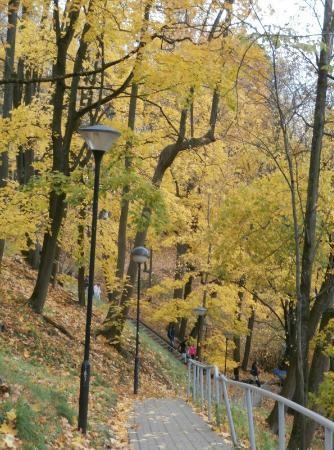
The photo at right: Mountain Toomemägi in Tartu
For example, the name of the second largest city in Estonia, Tartu is quite convincingly decrypted using the Chuvash language. Chuv. tără "summit" and semantically related tu "a mountain" correspond to the terrain, as the city has a mountain Toomemägi. When the number of such cases is fairly high, in general, the probability of the plausibility of the whole set of transcripts increases, despite some non-systematic errors. Some examples of other situational motivations for names are discussed below.
Sometimes such place names occur when their components are in close semantic and logical connection and correspond to the terrain that the random coincidences seem incredible. For example, more than ten settlements in Germany, France, Switzerland, and Austria, have the name Aspach. When we divide the word into two components and translate them as Chuvash words, we will see how they fit together – Chuv. ash "to puddle mud, wade sinking (in mud, snow)" and păhh "puddle, feces, muck". These settlements are located in muddy areas once.
Two villages with strange names for the Poles Shury and Shurypily are located among the Masurian marshes. Taking into account Chuv shur "swamp", the search for decrypting the second word is going to be successful. If Chuv. pile "buzz" (about mosquitoes) add to Chuv. shura, the name can be understood as "mosquito swamp". Buzzing mosquito clouds over the marsh gave a good reason for such a name. This conjecture is confirmed by a similar interpretation of the ancient name of Tallinn Kolivan using Chuv. külĕ "lake" and văn, imitating the hum of insects. Lake Ülemiste is very close to Tallinn, and it is an additional argument in favor of this interpretation. Nuremberg's name is well explained using Chuv. nür "humid, wet" and en "side", and this explanation is confirmed by preserved alluvial sediments of floods of Pegnitz River in the northern and north-eastern part of the city. Interpretation of another German town Baruth, in Brandenburg in the locality Fläming, rich in massive chalk sediments is perfect by Chuv. pur "chalk", ută "valley".
The Turkic people originally belonged to the European race. A study of skulls from burials of CWC gives grounds to say that the carriers of them were naturally people of Caucasoid type


Left: The portrait of a buried boy 14-14 years old on the settlement Zoziv I. Reconstruction after the skull was made by G.V. Lebedynski (SVESHNIKOV I.K. 1974, Fig. 33).
Right: The portrait of a buried man 20-22 years old in the village of Pochapy of Lviv Region Reconstruction after the skull was made by Gerasimov M.M.(SVESHNIKOV I.K. 1974, Fig. 21)
Nomadic Turkic people had no permanent place of residence, their stationary settlement appeared after changing the economy to a mixed form of animal husbandry and crop farming. Corded Ware culture, certainly was created by nomads, so the names of settlements attributed to the Turkic people refer to later times when they settled down. Although the space of their settlements could remain the same.
Comparing the location on the map of Turkic place names and CWC sites, as well that the Turkic tribes originally inhabited the steppe zone, we can trace the direction of their migration.
The largest cluster of Turkic place names is observed in western Ukraine. The eastern boundary of the cluster extends approximately along the Zbruch River. No sites of CWC were detected to the east of it too. In principle, the nomadic Turkic people had to occupy almost treeless Podilla fully, however, they moved further westward in the forest zone of the Upper Dniester, which begins beyond the Hnyla Lypa River. Here operated the same reason as in the movement to the north – the area was fairly densely populated by farmers of Trypilla culture whose sites here have been found in number more as 300. It was simply impossible for Nomads to find pasture for livestock of the required size. The density of the Trytillian population decreases gradually beyond the Zbruch River on the left bank of the Dniester River, and the Turkic people begin settling here. The Trypillian settlements interspersed with Türkic ones become rarer, although, on the right bank of the Dniester River, they are still drawn by the thick band to the mouth of the Hnyla Lypa River, and then disappear almost completely. Judging by the numerous toponymy, the majority of the Turkic people stopped in these places for a long time but gradually settled into neighboring lands. Another part in two separate groups moved westward along the Carpathian Mountains and north bypassing settlements of Indo-Europeans. Separated from the main bulk, some part migrants passing through the Moravian Gate settled in Moravia and Bohemia, where they got into Bavaria.
The Turkic people, namely the Proto-Chuvashes stayed in Western Ukraine until Scythian times, when a new wave of their expansion across the Carpathians, on the Left Bank Ukraine and the Black Sea steppes started, as it still goes ahead. But here they became creators of cultures Komariv (15-12 cen. BC) and Vysotska (11-7 cen. BC) and took part in the creation of later cultures, it is difficult to say of which namely without purposeful analysis of archaeological remains of the second half of the 1st cen. BC. But there is no doubt that some of the Proto-Chuvash population remained in their places before the arrival of the Slavs, as evidenced by similar motifs in the folk cultures of Chuvash and Ukrainians. Reliable material traces of their presence can be found too, such as, for example, in runic characters cave temple on the Dniester River bank. Their similarity with known Turkic runes evidenced they were left by the Proto-Chuvashes. Moreover, one inscription on the altar of the temple was deciphered using the Chuvash language
Turkic-Slavic Language Connections are considered separately. Here, for more convincing, we will consider examples of place names in Germany, interpreted using the Chuvash language.
Aisch, Neustadt an der Aisch, a small town in the northern part of Bavaria – Chuv uj "field", jysch "family, owner, farm" (in other Türkic jiš "forest").
Ascha, a municipality in the district of Straubing-Bogen in Bavaria – Chuv ăšă "warm".
Baar, a municipality in Aichach-Friedberg district, in Bavaria – Chuv. păhăr "copper"
Bacharach, a town in Rhineland-Palatinate, – Chuv. păhăr "copper", akh "evil spirit". There is a historic copper mine Fischbach forty kilometers to the southwest from the town, open to visitors. In the town, there is a restaurant "At Copper Jug".
Basel, a city in Switzerland – Chuv păsăl "to spoil, deteriorate"
Böhl-Iggelheim, a municipality in the Rhein-Pfalz-Kreis, in Rhineland-Palatinate -Chuv ikkĕle "to double", ikkĕllĕ "duality".
Borna, a town in the Free State of Saxony
– Chuv parne "present, gift".
Cham, the capital of the district of Cham in the Upper Palatinate in Bavaria – Chuv khum "wave".
Cottbus, a city in Brandenburg, – Chuv kat "dike, dam" and păs "to break, disturb".
Hanower, the capital of the federal state of Lower Saxony – Chuv khăna "guest", vere "custom, usage".
Hartha, a town in the district of Mittelsachsen, in the Free State of Saxony – Chuv khărta – 1. "patch, clout", 2. "rough country".
Homburg am Main, an integral part of the community Triefenstein in Main-Spessart district (Bavaria) – Chuv. khum "wave".
Jena, a University city in Thuringia – Chuv yĕnĕ "den, lair, couch".
Jüterbog, a historic town in the Teltow-Fläming district of Brandenburg – Chuv yüte "to be exhausted", păk "to sleep, die"
Kandel, a town in the district of Germersheim, in Rhineland-Palatinate and a mountain of the Black Forest – Chuv kăn "potash", tĕl "place, country". Potash was received from wood in the Black Forest long since.
Kiel, the capital of northern German state of Schleswig-Holstein – Chuv kil "house, family, yard".
Kirkel, a municipality in the Saarpfalz district, in Saarland – Tschuv khyr "pine-tree", kĕl "ash".
Kyritz, a town in the Ostprignitz-Ruppin district, in Brandenburg – Chuv kĕr "Herbst", eç "work".
Nohra, a municipality in the Weimarer Land district of Thuringia, – Chuv nakhra "horn".
Nürnberg (at first Nuremberg), a city in the state of Bavaria – Chuv nür "moist, humid", en "site, land".
Pankow, the highest populated and the third borough of Berlin – Chuv pankav "silly"
Parchim, a town in Mecklenburg-Vorpommern – Chuv par "to give", khĕm "fire, flame".
Perkam, a municipality in the district of Straubing-Bogen in Bavaria – Chuv pĕr "lonely, single, whole, alike", kăm "ash".
Salem, a municipality in the Bodensee district of Baden-Württemberg – Chuv selĕm "good, nice, beautiful"
Tarthun, a village and a former municipality in the district Salzlandkreis, in Saxony-Anhalt – Chuv tărtan "to swell", turtăn "to stretch out, lengthen", turtăm "load"
Zorge, a municipality in the district of Osterode, in Lower Saxony, Germany – com Türk. jorğa/jurğa "pacer", "amble" (Chuv çărkha).
Many names are found coming from Сhuv. pulăkh "fertility". Only in Bavaria, there are eight settlements called Pullach. In Ukraine, there is the town of Bolekhiv and two villages of Bulakhivka, in Poland, there are three villages of Bolechowice and villages of Bolechowo and Bolechów, in Russia – the cities of Bolekhovo and Bolkhov, the villages of Bulakhi in Ukraine and Belarus, the town of Bulach in Switzerland. Fertile lands were preferable for both farmers and pastoralists.
The fact that agriculture played an important role in the economy of the ancient Turkic people is confirmed by the names of the Russian villages Akulovo, Okulovo, Akulino, and others of the same root. Explanation of these names, which number is more than sixty, is fairly easy by Chuv aka "arable land, plowing" with the affix -a, forming adjectives with a similar value from the nominal stem.
The names of Cherkassy, Cherkasy, Charkasy, which can be deciphered as "autumn settlement" (Chuv. kĕr "autumn, of autumn" and kassy "village, street, settlement") are common in Russia, Ukraine, Belarus, and Poland. They talk about the peculiarities of nomadic cattle breeding. This interpretation corresponds to the widespread Turkic qyshlaq, which is translated as "wintering" (from the qysh "winter" of the same origin as the Chuv. kĕr). Turkic pastoralists grazed their cattle in a nomadic way in the summer, and with the arrival of autumn, they stopped at one place, where they stored hay for the winter in advance. The level of development of social relations is expressed by names derived from a word similar to Chuv. payăr "own", such as Boyarka and Boyary, or Bavaria (German Bayern).
The large number of settlements whose names have the root of turk/ turk (Turkovo, Turka, Turku, Túrkeve, Turkeye, Thürkow, Thurgau, Turgi, Torgau, etc.) speaks of the significance of trade in the economic activity of the Turkic [eople. There are more than twenty of these names in Russia, Ukraine, Poland, Hungary, Germany, the Netherlands, Switzerland, and Finland. All of them come from Old Chuvash *turku "place of exchange, trade" (cf. Chuv tukhi "bidding").
The names of Baar in Switzerland and Bacharach in Germany are associated with the mining or processing of copper (Chuv păkhăr "copper"). The name of the Swedish town of Sösdala speaks of the weaving craft (Chuv süs "hemp, fiber" and tala "homespun cloth"), and the name of the Ukrainian village of Gavarechchin does about pottery (Chuv kăvar "burning coals, embers", ěççyni "worker"). Numerous names of Yam and Yampol speak about practicing tar production (Chuv yam "tar distillation"), and names such as Kandaurovo, Kandel, and Kantelina do about the production of potash (Chuv kan "potash").
At first glance, the existence of many settlements in Europe for four millennia seems incredible, but that is how it was. Archaeological finds indicate that there was hostility between the Turkic people and the local population, which led to violence and revenge. Future comprehensive studies can more accurately determine the sex and age structure of the population of the European continent, but it can already be said that the Y chromosome brought by the Turkic people dominates in Europe (KRAUSE JOHANNES mit TRAPPE THOMAS. 2020: 131). Meanwhile, the difference in housekeeping between the autochthonous and alien populations was small, both were farmers. The main difference was in the details of livestock farming. If the local population had one or two cows per family, the steppe aliens owned entire herds of cattle. Although the cows of those times gave several times less milk than modern ones, the milk diet contributed to an increase in the number of children in Turkic families. In addition, they improved the technology of grain growing, which also contributed to population growth.(Ibid. 2020: 132-136).
Following the CWC, the Bell Beaker culture developed in Central Europe, the ethnicity of which cannot yet be determined with certainty. The noticeable harmony in the relations of the bearers of both cultures seems to indicate that both were of Turkic origin. A scrupulous analysis of Turkic toponymy can to some extent answer this question. It is not possible to provide a complete list of Turkic toponymy here. It is provided for individual countries (see links below).
However, the question inevitably arises. If genetics testifies to the large number of Turkic peoples in Western Europe and this is confirmed by toponymy, then why have the Turks not survived in Europe to this day? This question can be answered as follows. Most of the Turkic people who migrated from the steppes were men who married local women and had many children. The children were raised by their mothers in their language, so they learned their mothers' language better than their fathers. The same story happened in Bulgaria in the first millennium AD. The mothers' language became the native language of the children, although the name of the people is of Turkic origin.
Acknowledgments: Stephan Niemeier (Frankfurt am Main) for consultation and material support for the research.
The Complete List of the Ancient Turkic Place Names in Russia and Belarus
(In Russian)
The Complete List of the Ancient Turkic Place Names in Ukraine
(In Ukrainian)
The Complete List of the Ancient Turkic Place Names in Eastern Europe
The Complete List of the Ancient Turkic Place Names in Central and Northern Europe


